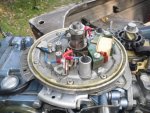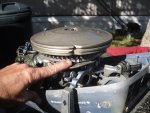Re: 1975 evinrude 9.9 fuel pump prob?
First thing to do is re-torque the head, just to be sure you don't have a leak to the water jacket, you did use a new gasket and lap the head flat on a flat surface, right?
The timing marks on the flywheel are on the bottom edge, and face downwards, making them hard to see unless you look up at the bottom edges of the flywheel.
Did you just overhaul this engine? If so, I would suspect the timing, use a timing light as this tells you what is going on while it is running, checking the points gap with the flywhell off does not verify the ignition is working correctly, but a timing light will. You need to power the timing light from a 12 volt battery.
Verify you have the low speed mixture needle about 1.5 turns out as a starting setting.
Verify the plugs are not fouled, easy troubleshooting technique is to replace them.
Listen to the engine breath with the carb opened a little while slowly rotating the flywheel by hand, you should hear the reeds honking/wheezing as each piston starts it's upward travel, indicating proper crankcase compression, and both cylinders should test about the same. Feel for even resisitance from compression in each cylinder as you do this.
Pull the spark plugs, but plug them back into the plug wires and lay them against the lower cowl or block so the spark can jump the plug's gap. Now pull the engine through and look for bright blue spark. New points have a coat of lacquer on them, clean the points with MEK, or lacquer thinner by dipping a clean business card in the solvent and passing it between the points contacts. You may have to do this several times. This has stung me more than once! While you have the plugs out, but grounded, again spin the engine over slowly and listen for the "thoopah-thoopah" noise each cylinder will make as it's piston reaches the bottom of the stroke and uncovers the transfer ports, letting the crankcase vent into the cylinder; both cylinders should sound equall and have equall resistance as you turn the engine over...this is another test of crankcase compression and sealing.
If you have a bad seal on one cylinder, a leaking reed, a restricted reed, a case leak, or the timing is off due to the points not making good contact, or out of adjustment, the engine will not run right. If you have too rich of a low speed mixture, it will start with minimal choking but get rougher and die as it warms up.
Are you sure it has the thermostat installed and sealed correctly? I once had an engine that the head was corroded in the thermostat seal area, so it would not seal and over cooled. In this instance, the cylinders, head, and plugs never got warm so it would foul out and die at idle. I wound up replacing the head. The head and top of the block should get hot enough that you cannot keep your hand on it for more than several seconds without it becoming uncomfortable.























